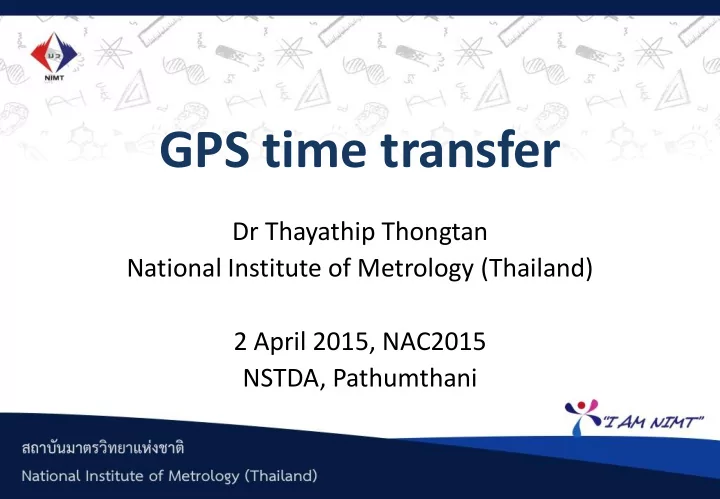

GPS time transfer Dr Thayathip Thongtan National Institute of Metrology (Thailand) 2 April 2015, NAC2015 NSTDA, Pathumthani
Outline 1. NIMT time and frequency laboratory 2. GPS time transfer 3. Future plan 4. Summary
1. NIMT time and frequency laboratory Time keeping responsibilities consist of: • generating Coordinated Universal Time (UTC). • The UTC time scaled kept by NIMT is called UTC(NIMT). • It is determined by operating 3 Caesium frequency standards at 24/7 and in an environment controlled room; • keeping time-link with the Bureau of Weights and Measures (BIPM) by contributing in the International Atomic Time scale (TAI). The differences of each of our clocks and GPS observations are measured daily.
1. NIMT time and frequency laboratory Geographical distribution of the laboratories that contribute to TAI and their time transfer equipments.
1. NIMT time and frequency laboratory NIMT National Standards 2 nd Level Calibration Laboratories: Standards in-house or commercials 3 rd Level Standards Production lines Measuring and Testing Equipment and Industrial testing laboratories
1. NIMT time and frequency laboratory Time disseminations are through: • calibration services; – In-house services – Remote calibration service : use a GPS Common-view technique • Internet network by applying the Network Time Protocol (NTP); • radio frequency via FM using the Radio Data System (RDS); • telephone network.
2. GNSS time transfer • Loran-C – Accuracy achieved were 100s ns. – It does not cover large area. • GPS Accuracy reaches 1 ×10 -12 or 0.001 ns. – – Worldwide coverage (baseline is up to 1,000 km). – GPS has precision, accuracy and coverage.
2. GNSS time transfer • GPS time – is a time scale established by the control segment and related to UTC(USNO). – is a atomic continuous time scale (does not include leap second). – UTC-GPS time = -16 s. (from August 2012) – UTC-UTC(USNO) < 2 ns.
2. GNSS time transfer • GPS time receiver – Channel: single or multi-channels. – Measurement: C/A or P-code. – Determine: reference clock. – Known: satellite positions and satellite clock offsets from navigation message. – Data files: navigation message, observation files are in RINEX format, transformed into CCGGTTS format. • CGGTTS = Common GPS GLONASS Time Transfer Standard.
2. GNSS time transfer • Measurement model DT = pr – (r/c + dS + dI + dT) – dD + dc pr pseudorange r range c speed of light dS correction due to earth rotation (Sagnac effect) dI ionospheric delay dT tropospheric delay (model) dD receiver delay dc clock offsets • Tracking time is 13 minutes. • Antenna position and coordinate are determined in the GPS reference frame (WGS84)
2. GNSS time transfer • Two receivers or more observe the same satellite at the same time. • Accuracy is < 1 ×10 -12 . • Computation is as: Clock(NIMT) – Clock(Ref) = Ta Clock(Client) – Clock(Ref) = Tb Clock(NIMT) – Clock(Client) = ?
3. Future plan Q: With multi-constellation satellites, what can be reference? A: This can be the common reference Clock(Ref): • Satellite clock (in common-view) • GPS time • GLONASS time • Galileo time • IGS time
3. Future plan GLONSS Galileo BeiDou GPS GNSS common-view Clock(NIMT) – Clock(Client)
3. Future plan: all-in-view Clock(Client) – Clock(Ref) Clock(NIMT) – Clock(Ref)
3. Future plan: instruments • Time receiver, currently used at NIMT. • Outputs: CGGTTS, RINEX • Advantage: – 1PPS from this receiver is directly compared to the reference source (No additional frequency). – CGGTS data is directly available. • Disadvantage: – RINEX data is effected by the TIC measurements.
3. Future plan: instruments • Geodetic receiver • Output: RINEX and can be converted to CGGTTS data. • Advantage: – No additional noise from TIC. • Disadvantage: – Need additional measurement to get the UTC(k).
4. Summary • NIMT is the sole organisation in Thailand to maintain the national standards and provide several services to the communities. • Time and frequency lab role is to keep and to disseminate the Thailand standard time and frequency, and throughout the country. • NIMT practices of GPS time transfer include in two activities namely a) international time keeping for the maintenance of the UTC(NIMT) with the BIPM and b) remote calibration services for frequency calibrations within Thailand. • Time transfer technique currently used at NIMT for calibration service is GPS common-view from code measurement from our dual frequency time receiver. • Future plan is to apply the geodetic precise point positioning technique for the remote frequency calibration services from the GNSS geodetic receiver.
Thank you for your kind attentions! thayathip@nimt.or.th
Recommend
More recommend